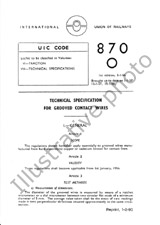We need your consent to use the individual data so that you can see information about your interests, among other things. Click "OK" to give your consent.

UIC B190/RP4-1ed.
Gauge changeover systems - Description of a harmonised approval procedure for Automatic Gauge Changeover Systems
Translate name
STANDARD published on 1.12.2017
The information about the standard:
Designation standards: UIC B190/RP4-1ed.
Publication date standards: 1.12.2017
SKU: NS-1190430
The number of pages: 83
Approximate weight : 280 g (0.62 lbs)
Country: International technical standard
Category: Technical standards UIC
Annotation of standard text UIC B190/RP4-1ed. :
Within the European Union, the 1520 mm track gauge is in use in Finland, Latvia, Lithuania, Poland and Slovakia. Some of these countries apply both the UIC and the OSJD rules, particularly for the purposes of East-West transit traffic for freight. For traffic operating between different systems, vehicles must satisfy the rules of UIC and OSJD. These vehicles and their components must be approved against the UIC and OSJD rules from a technical and operational point of view. Here, the relevant technical and operational regulations of UIC leaflets in the 400, 500 and 800 series, OSJD (leaflets, GOS) and the EU regulations (TSI, EN) will be of significance. To reduce the time requirement and associated high costs of approval and certification in third countries, procedures must be developed to permit a simplified or common approval and/or certification regime. The present report provides an analysis of existing approval and certification procedures for vehicles with automatic gauge changeover systems and fixed gauge changeover facilities. The authorities or entities in charge of approval and the documents to be submitted to these bodies are listed in the report. In addition, a proposal is made for a common approval procedure for gauge changeover systems (vehicles and fixed facilities). This report is the output of Sub-Task 5 (of 5 Sub-Tasks in total) as part of the "Automatic Gauge Changeover Systems" project. "+ "
Name:Spurwechselsysteme - Beschreibung eines einheitlichen Zulassungverfahrens für automatische Spurwechselsysteme| In der Europäischen Union wird die Spurweite 1.520 (1.524) mm in Finnland, Lettland, Litauen, Estland sowie für einzelne Strecken in Polen und der Slowakei verwendet. Einige dieser Länder wenden sowohl die UIC als auch die OSShD-Regeln an. Dies bezieht sich vor allem auf den Ost-West-Güterverkehr. Für den systemüberschreitenden Verkehr müssen Fahrzeuge den Regeln der UIC und der OSShD genügen. Dazu müssen diese Fahrzeuge und Fahrzeugkomponenten aus technischer und betrieblicher Sicht nach den Regeln der UIC und OSShD zugelassen werden. Dabei sind die jeweiligen technischen und betrieblichen Vorschriften der UIC (Merkblätter der Serien 400, 500 und 800), OSShD (OSShD Merkblätter, GOST) und die EU-Regeln (TSI, EN) von Bedeutung. Um den Zeitaufwand und die damit verbunden hohen Kosten zu reduzieren, die für die Zulassung und Zertifizierung in Drittländern erforderlich werden, sind Verfahren zu entwickeln mit denen eine erleichterte oder gemeinsame Zulassung bzw. Zertifizierung erreicht werden kann. In diesem Bericht werden die bestehenden Zulassungs- und Zertifizierungsverfahren für Fahrzeuge mit automatischen Spurwechselsystemen und ortsfesten Spurwechselanlagen analysiert. Die für die Zulassung zuständigen Behörden bzw. Stellen sowie die diesen Stellen vorzulegenden Unterlagen werden aufgezeigt. Außerdem wird ein einheitliches Zulassungsverfahren von Spurwechselsystemen (Fahrzeuge und ortsfeste Anlagen) für den Bereich der UIC und OSShD vorgeschlagen. Dieser Bericht ist das Ergebnis der Teilaufgabe 4 von insgesamt 5 Teilaufgaben des Projektes "Automatische Spurwechselsysteme". "+ "


 Cookies
Cookies
